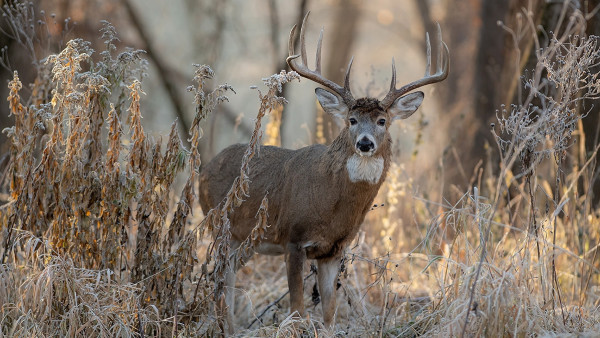
In 2020, I drew a coveted Iowa archery tag. The plan was to hunt public dirt as much as I could in October, because I had some work obligations that would take me away during November. During opening weekend, I hunted, scouted, and found three areas that were littered with buck sign.
When I drove back down to hunt during the middle weekend of October, I realized something. There were a lot more hunters out. I figured the deer would be pushed deeper into the cover, so I went looking with a stand on my back.
One of the heavy-use areas I found allowed me to cross a creek and get over a mile from the road. As I slipped in to look around, I watched a doe and two fawns bound away. Then another, much bigger deer took off. The way they ran led me to believe they might come right back along the river, so I scrambled to set up where I could shoot two different trails.
The first deer to come back was a main-frame 10 with a broken tine. It was the buck I had jumped less than an hour earlier, and he was big enough to wear my tag. That buck, as spooked as he was, wasn’t all that spooked. It was a good lesson.
Ground Spooking
That Iowa buck I killed let me walk right into his bedding area. This probably happens on that chunk of public land dozens of times each season. It barely phased him. He busted out, waited a little while, then walked back in. I’ve seen mature bucks do that other times, too. It never ceases to amaze me, but here’s the thing—even on pressured properties, busting a buck while you’re walking around isn’t that big of a deal.
They are used to it. Now, you might say that a deer that is on a different, low-pressure property, might react differently to someone showing up where people rarely walk. I don’t think so. I think we underestimate how often we push bucks around, because we tend to think of it only in terms of the immediate pre-season, or during the hunting season.
But we bump bucks when we shed hunt and winter scout, too. We bump them when we are looking for morels in the spring, or trying to shoot a gobbler. Even the most babysat deer out there get pushed around, and I’d rate that kind of spooking as low danger. It’s the opposite of getting busted on stand.
Stand Spooking
I’d rather bump into a buck while walking in the woods 10 times than have that same buck bust me in the tree just once. A deer that sees you in a stand or a blind is a deer that is going to be extremely cautious around that stand or blind.
I think the tolerance level here is really low, especially with pressured deer. This might be bananas, but I think even trail cameras can spook deer to the point where they’ll avoid them. If that’s true, then it’s not a stretch to believe that the negative impacts of a buck busting you reaching for your bow in your favorite ladder stand is going to change your odds of ever killing him, there, greatly.
Surprise, Surprise
We all know that the first time you sit a stand is when you have the best chance of killing a big buck. Stand sites can reset if they are rested enough, but it’s a better bet to understand the level that you spooked a deer.
If he caught wind of you while he was 100 yards out, and just kind of turned tail to walk away, maybe he’s killable there in a few weeks. If he was 20 yards out and looked right at you as you drew your bow and shot under his belly, you might not ever see that deer from that stand again. He won’t abandon his home range, but that particular site is probably as good as done.
The more options you have for ambush sites, and the more sneaky routes you have to get into and out of areas, the more you can use the element of surprise. This negates some of the bad effects of spooking deer, which is inevitable. It’s also a good strategy to adopt, regardless of how often you booger big deer out of certain areas.
Remember that this season. Assume you’re spooking some deer you don’t see, and pay real close attention to the ones you can see that you do spook. Each time can (and should) alter the course of your hunting plans, but that doesn’t mean you’re out of the game. You just need to be honest about the level of alarm, and how you’ll surprise that deer later with a new setup.
For more information on whitetail hunting, check out these articles: Early Season Calling Tips, How To Kill An Early-Season Buck In The Morning, and Why Opening Week Is Better Than The Rut For Mature Whitetails.







Conversation